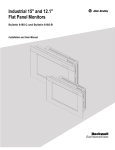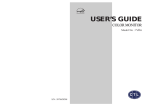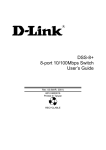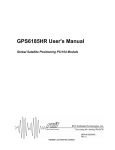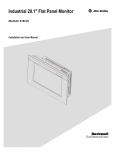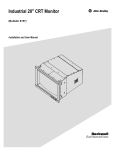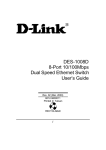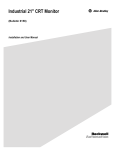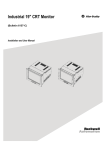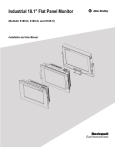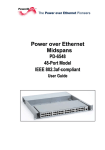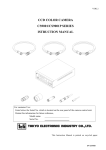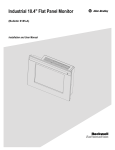Download 6185-UM003A-EN-P, 6185 Economy User Manual
Transcript
Economy Line Industrial Flat Panel Monitors Bulletin 6185-H, 6185-J and 6185-K Installation and User Manual 2 6185 Economy Line Monitors 6185 Economy Line Monitors............................................. Description ........................................................................... Part Numbers........................................................................ Installing Your Monitor ...................................................... Before you Begin.................................................................. Installing Your Monitor......................................................... Installing your Monitor in a Panel ......................................... Installing Your Monitor in a Rack ......................................... Making Connections ........................................................... Connecting a Host Video Source........................................... Connecting the Touchscreen Interface (Optional) .................. Connecting Power................................................................. Disabling the Keypad............................................................ Configuring Video Setup .................................................... Setting the Monitor Type ...................................................... Check Operating Resolution ................................................. Performing AUTO Setup ...................................................... Adjusting Your Monitor Using the On-screen Display........... Verifying the Coarse Settings ................................................ Verifying Fine Settings ......................................................... Verifying Horizontal and Vertical Positions ........................... Setting Brightness and Contrast ............................................ OSD Menu Reference ........................................................... Performing Routine Maintenance ...................................... Cleaning ............................................................................... Replacing a Line Cord .......................................................... Other Maintenance................................................................ Troubleshooting and Support............................................. Self-Test ............................................................................... Troubleshooting Solutions .................................................... Allen-Bradley Support.......................................................... Appendix A: Installing Rack Brackets on the 6185-H ....... Appendix B: Monitor Dimensions...................................... 6185-H (15” Panel Mount) Dimensions ................................ 6185-J (17” Panel Mount) Dimensions.................................. 6185-K (17” Rack Mount) Dimensions ................................. Appendix C: Touchscreen Serial Interface ........................ Description ........................................................................... Setting Up the Touchscreen Interface .................................... Appendix D: Video Cables.................................................. HD-15 Video Connector ....................................................... Appendix E: Product Specifications................................... Publication 6185-UM003A-EN-P 4 5 7 8 8 9 10 13 15 16 17 18 19 20 21 22 23 25 26 26 27 27 28 30 30 30 30 31 31 32 34 35 36 36 38 40 41 41 41 44 44 45 3 Important User Information Solid state equipment has operational characteristics differing from those of electromechanical equipment. "Safety Guidelines for the Application, Installation, and Maintenance of Solid State Controls" (Publication SGI-1.1) describes some important differences between solid state equipment and hard-wired electromechanical devices. Because of this difference, and because of the wide variety of uses for solid state equipment, all persons responsible for applying this equipment must satisfy themselves that each intended application of this equipment is acceptable. In no event will Rockwell Automation be responsible or liable for indirect or consequential damages resulting from the use or application of this equipment. The examples and diagrams in this manual are included solely for illustrative purposes. Because of the many variables and requirements associated with any particular installation, Rockwell Automation cannot assume responsibility or liability for actual use based on the examples and diagrams. No patent liability is assumed by Rockwell Automation with respect to use of the information, circuits, equipment, or software described in this manual. Reproduction of the contents of this manual, in whole or in part, without written permission of Rockwell Automation is prohibited. Throughout this manual, we use notes to make you aware of safety considerations. ATTENTION: Identifies information about practices or circumstances that can lead to personal injury or death, property damage, or economic loss. Important: Identifies information that is especially important for successful application and understanding of the product. Publication 6185-UM003A-EN-P 6185 Economy Line Monitors This manual provides installation, operation, and maintenance instructions for the Allen-Bradley 6185 Economy Line monitors. This manual supports the following models: • 6185-H 15.0” Panel Mount • 6185-J 17.0” Panel Mount • 6185-K 17.0” Rack Mount Note: If you want to mount your 15” monitor into a 19” rack, you can use the optional rack adapters brackets. Figure 1 6185-H (15”) Panel Mount Figure 2 6185-H (15”) Panel Mount with Optional Rack Adapter Brackets Figure 3 6185-J (17”) Panel Mount Figure 4 6185-K (17”) Rack Mount Publication 6185-UM003A-EN-P 6185 Economy Line Monitors Description 5 The 6185 Economy Line monitors offer the following: • One-button automatic screen setup • Front panel keypad with lockout feature • External 90-264 VAC Power Supply • Plug and Play and Energy Star compatible • NEMA 4/4X/12 (IP65/IP53 equivalent) front panel Capabilities specific to the 6185-H include the following: • Thin enclosure (2.4in [61mm]) • 256K color (18-bit) display • Bright (200 nits) Active Matrix-TFT 1024x768 display • Video formats supported from 640x480 to 1024x768 • Fast response time (<25 msec) • 120°H, 100°V viewing angle • Rack mount adapter brackets (EIA-19 8U) option Capabilities specific to the 6185-J and 6185-K include the following: • Thin enclosure (2.5in [63mm]) • 16.7M color (24-bit) display • Bright (170 nits) Active Matrix-TFT 1280x1024 • Video formats supported from 640x480 to 1280x1024 • Fast response time (<40 msec) • 160° viewing angle Touchscreen Option A resistive antiglare touchscreen option is available for all models of 6185 Economy Line monitors. Publication 6185-UM003A-EN-P 6 6185 Economy Line Monitors Package Contents The shipping cartons contain the following items: • Monitor • ScreenSet monitor setup utility • Package of mounting hardware • AC power cord • Video cable • This user manual A monitor with a touchscreen option ships with these additional items: • Supporting software and manuals • RS-232 serial extension cable Publication 6185-UM003A-EN-P 6185 Economy Line Monitors Part Numbers 7 The part number for your particular unit consists of the Bulletin number (6185) followed by a seven-digit code indicating the display size and enclosure (H, J, or K) and options on your unit. Following are explanations of the part numbers for the various models of monitors. Example: 6185 J C C J A A Z 1 2 3 4 5 6 7 8 Table A Catalog Number Explanation for 6185 Economy Line Monitors Position 2 Option Monitor Size Option Letter Category Description H 6185 15.0” Panel Mount J 6185 17.0” Panel Mount K 6185 17.0” Rack Mount –9U 3 Front Panel Type C Plastic Front Panel 4 Touchscreen/ Display Shield C Resistive Antiglare Touchscreen Z Polycarbonate Display Shield 5 Power Input J Ext. 120/240 AC input, USA Power Cord 6 External Video Cable A 6 foot (1.8 meter) HD15-HD15 Cable 7 Touchscreen Serial Cable A 6 foot (1.8 meter) DE9-DE9 Cable Z None (non-touchscreen only) 8 Accessories R Rack Mount Adapter Brackets (EIA19-8U), 6185H only Z None Publication 6185-UM003A-EN-P 8 6185 Economy Line Monitors Installing Your Monitor Before you Begin This section describes how to install 6185-H, 6185-J and 6185-K monitors. When installing the monitor, it is important to consider environmental factors that could affect performance as well as possible effects from equipment operation on personnel and nearby equipment. The figure on the left displays the general process to install, connect, and adjust your monitor. Installation Guidelines Following these guidelines will help ensure that the monitor provides safe and reliable service. • Ensure that sufficient power is available from a single phase AC outlet at the site. • Ensure that sufficient space is available around air inlets and outlets to provide the circulation necessary for cooling. Never allow air passages to become obstructed. • Ensure that the ambient air temperature will not exceed the specified maximum temperature. You may need a user-supplied fan, heat exchanger, or air conditioner to meet this condition in some installations. Note: Remember that heat rises—many times the temperature at the top of an enclosure is much higher than the rest of the enclosure if the air is not circulating. Important: This monitor is designed to operate at a range of extremes, however it is not good design practice to continuously operate the monitor at the highest end of the specified temperature range. While the product will operate at its highest specified temperature, the overall life span of any electronic device is shortened when it operates at its highest rated temperature. • Leave the monitor’s enclosure or cover in place at all times during operation. The cover affords protection against high voltages inside the monitor and inhibits radio-frequency emissions that might interfere with other equipment. Publication 6185-UM003A-EN-P Installing Your Monitor 9 • The Federal Communications Commission has prepared a pamphlet that addresses the problem of radio frequency interference to radio and television reception, which should be consulted in case of problems with such interference. This publication, “How to Identify and Resolve Radio/TV Interference Problems” (Stock #004-00000345-4) may be obtained from the US Government Printing Office, Washington, DC 20402. • Determine the minimum and maximum ambient humidity for the monitor by consulting the Appendix E: Product Specifications on page 45. Ensure that the humidity of the ambient air will not exceed these limits. In very dry environments, static charges build up very readily. Proper grounding of the equipment through the AC power cord can help reduce the likelihood of static discharges, which may cause shocks and damage electronic components. Installing Your Monitor Depending on the options you selected when ordering your 6185 Economy Line monitor, you can install your monitor in of the following ways: • Panel mount • Rack mount Before Unpacking the Monitor Before unpacking a new monitor, inspect the shipping carton for damage. If damage is visible, immediately contact the shipper and request assistance. Otherwise, proceed with unpacking. Note: Make sure you keep the original packaging for the monitor in case you need to return the monitor for repair. Publication 6185-UM003A-EN-P 10 6185 Economy Line Monitors Installing your Monitor in a Panel Panel mount monitors are designed to provide protection against water and dust to NEMA 4/4X/12 (IP65/IP53 equivalent) standards. Slides or shelves are not required because the panel mount monitor is designed to be supported by the panel in which it is installed. Figure 5 Generic Panel Mount Diagram Note: Your monitor may differ from the above graphic. Tools Needed for Panel Mount Installation In addition to the tools required to make the panel cutout, you will need the following tools: • 3/8" deep well socket • ¼" drive extension – 6" or longer • ¼" drive ratchet or ¼" drive torque ratchet Publication 6185-UM003A-EN-P Installing Your Monitor 11 Panel Mounting Guidelines Observe the following precautions before installing the unit in a panel: • Confirm that there is adequate space behind the panel. Allow at least 1.0” (26mm) on the sides and bottom and 2.0” (51mm) on the top ventilation. − For a 6185-H (15” panel mount), a cabinet with a minimum depth of 2.9 in. (74mm) is sufficient. − For a 6185-J (17” panel mount), a cabinet with a minimum depth of 3.0 in. (76mm) is sufficient • Take precautions so that metal cuttings do not enter any components that are already installed in the panel. • Supporting panels should be at least 14 gauge to ensure proper sealing against water and dust and to provide proper support. The mounting hardware supplied accommodates panels up to 0.25 in. (6.35 mm) thick. Note: Supporting panels must be cut and drilled to specifications before installation. ATTENTION: Failure to follow these warnings may result in personal injury or damage to the panel components. Publication 6185-UM003A-EN-P 12 6185 Economy Line Monitors Installing Your Panel Mount Monitor Complete the following to install your monitor: 1. Prepare panel cutout for monitor. Refer to specific cutout drawings in Appendix B: Monitor Dimensions on page 36. 2. If access to the rear of the monitor is not available following installation, attach the cables to the monitor at this time. Refer to the figure on Page 15. 3. Install the monitor in the prepared cutout. 4. Install the lock nuts and washers, supplied with the monitor, around the perimeter of the monitor. Extra lock nuts and washers are provided. Note: Use #10-32 or M5 self-locking nuts for mounting. ATTENTION: You must apply nuts and washers on all studs for NEMA 4/4X/12 fluid applications. Mounting nuts must be tightened to a torque of 24 inchpounds to provide panel seal and avoid potential damage. Allen-Bradley assumes no responsibility for water or chemical damage to the monitor or other equipment within the enclosure due to improper installation. 5. Tighten all mounting nuts evenly to a torque of 24 inch-pounds. Publication 6185-UM003A-EN-P Installing Your Monitor Installing Your Monitor in a Rack 13 The 6185-K (17” rack mount) is designed for rack mounting, but you can also install the 6185-J (17” panel mount) into a standard rack. Using optional rack adapters, you can also install the 6185-H into a rack. The rack adapter option for the 6185-H is Accessory option R. For rack adapter installation procedures, see Appendix A: Installing Rack Brackets on the 6185-H on page 35. Tools Needed You will need the following tools: • EIA panel mounting hardware • Phillips screwdriver (medium) Rack Mounting Guidelines Observe the following precautions when installing this unit in a rack: • The cabinet must be tall enough to accommodate the monitor's panel height: − eight rack units, 14.00" (356 mm), for the 6185-H (15” panel mount) with adapter − nine rack units, 15.75" (400 mm), for the 6185-K (17” rack mount) • The cabinet must be deep enough to accommodate the monitor's depth while providing rear clearance for cabling and airflow. The following cabinet depths are sufficient: − 2.9" (74 mm) for the 6185-H (15” panel mount) − 3.0" (76 mm) for the 6185-K (17” rack mount) • No slides or shelves are required because the rack mount monitor is designed to be supported by the panels in which it is installed. Publication 6185-UM003A-EN-P 14 6185 Economy Line Monitors Installing a Monitor into a Rack 1. Verify that you have either eight rack units, 14.00" (356 mm), for the 6185-H (15” panel mount) or nine rack units, 15.75" (400 mm), for the 6185-K (17” rack mount) available to mount your monitor. 2. Locate holes in the rack mounting rails corresponding to the holes in the monitor front panel. Install clip nuts behind the holes in the rails if threaded rails are not provided. Note: The mounting rails that run vertically along the inside edges of the front opening of an EIA rack cabinet can be of two types: • “Wide” rails have holes spaced 0.5"(12.7 mm) and 1.25"(31.8 mm) on centers, in a repeating pattern. Wide rails are prevalent in Europe. • “Universal” rails have holes spaced 0.5"(12.7 mm), 0.625"(31.8 mm), and 0.625"(31.8 mm) on centers, in a repeating pattern. Thus, the universal rails have a hole pattern that contains the wide pattern but provides an additional hole at the midpoint of the pattern. Universal rails are most prevalent in the US. 3. Install the monitor into the cabinet from the front. 4. Secure the monitor chassis to the cabinet by installing panelmounting screws through the holes in the monitor’s front panel and into the rails behind. Publication 6185-UM003A-EN-P Making Connections 15 Making Connections The rear panels of both 6185 Economy Line monitors have connectors for attaching cables to accomplish the following: • Connecting to a host computer video source (HD-15 VGA connector) • Connecting to a host computer serial port for touchscreen • Connecting to power (IEC connector) In the figure on the left, the gray shaded areas represent where you are now in the general process to install, connect, and adjust your monitor. Monitor Connections The following figure shows standard configurations for your monitor. Note: Some connectors on your monitor may differ slightly from the following figure. Figure 6 6185 Economy Line Connections Publication 6185-UM003A-EN-P 16 6185 Economy Line Monitors Connecting a Host Video Source The video connection to the host is made through a HD-15 (female) connector. Note: For specifications on a HD-15 video cable, see page 44. To establish a signal using the HD-15 connector: 1. Connect one end of the included six-foot video cable to the female HD-15 video input connector. Figure 7 6185 Economy Line Video Cable Connections Note: You can use longer cables (up to approximately 75 feet in some cases), provided they are properly constructed. 2. Connect the other end to the output of any IBM-compatible VGA adapter or other video generator. Note: Publication 6185-UM003A-EN-P You may connect the monitor to video generators that do not conform to VGA standards. The main requirement is that the generator provides analog RGB video signals (0.714V above reference black into 75 ohms) and separate horizontal and vertical sync signals. Making Connections Connecting the Touchscreen Interface (Optional) 17 The serial touchscreen interface connection to the host is made through an RS-232 DE-9 (female) D-shell connector located on the side panel. The optional touchscreen provides a high-resolution touch input system. Driver software included with the package allows the touchscreen to function with many popular DOS and Windows® -based industrial applications as a pointing device (mouse). Note: Refer to Appendix C: Touchscreen Serial Interface on page 41 for additional details on the installation and operation of the touchscreen. To connect the touchscreen: 1. For units with the touchscreen option, make sure you have the serial cable. This is Touchscreen Serial Cable option A. 2. Connect one end of the touchscreen serial cable to the T/S port connector on the monitor. Figure 8 6185 Economy Line Touchscreen Connections 3. Connect the other end to a serial port (usually COM2) on the host computer. 4. Tighten the captive screws on the cable connector to secure it. Publication 6185-UM003A-EN-P 18 6185 Economy Line Monitors Connecting Power 6185 Economy Line monitors require a single-phase power supply providing 90 to 264V AC at 50 to 60 Hz. Power must be available at a grounded three-pin outlet located nearby. Whenever possible, connect the monitor to the same AC source that supplies the computer. To connect power to the monitor: 1. Turn off the main switch or breaker. 2. Connect the external power supply cable to the 12 VDC power input connector on the monitor. Important: If you need an extra cable restraint, Rockwell Automation provides a lance in the sheet metal, so you can secure the power cable to the chassis with a tie wrap. Figure 9 6185 Economy Line Power Connections 3. Connect the plug end of the AC power cord to the AC power connector on the external power supply. 4. Plug the other end of the AC power cord into the main outlet. 5. Restore AC power. Publication 6185-UM003A-EN-P Making Connections Disabling the Keypad 19 You can disable the keypad, if you wish. The keypad disable switch is covered with a hole plug. 1. Remove the plug with a small screwdriver. 2. Slide the switch to the right to disable the keypad. The left position keeps the keypad enabled. 3. Replace the plug when you are finished. Figure 10 6185 Economy Line Keypad Disable Switch If the keypad is disabled and a key is pressed, the LEDs on the front flash back and forth for about 5 seconds, indicating that the keypad is locked out. Publication 6185-UM003A-EN-P 20 6185 Economy Line Monitors Configuring Video Setup After making the connections, you are ready to setup your monitor. This section describes how to setup and configure your monitor. In the figure on the left, the gray shaded areas represent where you are now in the general process to install, connect, and adjust your monitor. Control Buttons and Power Indicator Figure 11 Front Panel User Controls Table B Control Buttons Control Menu Description Opens the OSD and sub-menus Selects the highlighted function Exit Exits the OSD Selects the Video signal (A or B) while the OSD is off (6185-J and 6185-K only) Auto Starts the Auto Video Adjustment function Brightness +/- Adjusts the brightness level if pressed while the OSD is off Moves between OSD menus and submenus Decreases or increases values LEDs Publication 6185-UM003A-EN-P There are two LEDs on the keypad: • Green LED On: Power good, video and sync signals are present and good. • Amber LED On: Monitor in power saving mode or power good, but video sync signals are not present (disconnected cable) or out of range. • Amber and Green LEDs Flashing: Key has been pressed when keypad is locked out. Configuring Video Setup Setting the Monitor Type 21 If you are using Windows 95, Windows 98 or Windows 2000, and your video card supports it, you should enable your workstation to detect Plug & Play monitors and select Plug and Play as the monitor type. If your video card does not support Plug and Play, or if you are using Windows NT, you should set the monitor type manually. The possible settings are: • “Plug and Play Monitor” - 6185-H, 6185-J and 6185-K monitors with Plug and Play enabled system • “Super VGA 1024x768” – 6185-H manual setting • “Super VGA 1280x1024” – 6185-J and 6185-K manual setting Note: These monitors use a flat panel display, but they use the workstation’s analog VGA interface. Because of this, some setup screens may indicate that the monitor is operating as a CRT (analog) device, rather than a flat panel (digital) device. Publication 6185-UM003A-EN-P 22 6185 Economy Line Monitors Depending on if you are using Windows NT, Windows 95 Windows 98, or Windows 2000 accessing the monitor type settings can differ. Use the following table as a procedure guideline for accessing the monitor types manually. Table C Procedures for Accessing Monitor Type Manually Windows NT Windows 95 1. Open Control Panel 1. Open Control Panel 1. Open Control Panel 2. Open Display icon 2. Open Display icon 2. Open Display icon 3. Click Settings tab 3. Click Settings tab 3. Click Settings tab 4. Verify Desktop Area (Resolution) set for the desired resolutions: 4. Click Advance Properties button 4. Click Advance Properties button 5. Click Monitor tab 5. Click Monitor tab 6. Click Change button 6. 7. Click Show all Devices button Click Show all Devices button 7. Verify Manufacturer: Standard monitor types Verify Manufacturer: Standard monitor types 8. Verify Models: Click Show all Devices button • Plug and Play Monitor 10. Verify Manufacturer: Standard monitor types • Super VGA 800x600 • Super VGA 1024x768 • Super VGA 1280x1024 • 1024x768 is best for 6185-H. • 1280x1024 is best for 6185-J and 6185K. 8. 5. Verify Refresh Frequency: 9. • 60 or 75 Hz is best. 11. Verify Models: Check Operating Resolution Windows 98/2000 • Plug and Play Monitor • Super VGA 1024x768 • Super VGA 1280x1024 Setting Up Video Resolution Flat panel monitors are fixed resolution devices and the image looks best when operated at their native resolution. However, 6185 Economy Line monitors have advanced scaling capabilities to make the display look as good as possible while running in non-native modes. If you switch the resolution of this monitor from the native resolution, the display may look slightly distorted due to replication techniques used to fill the full screen with an image. The native resolutions are as follows: • 1024x768 for 6185-H • 1280x1024 for 6185-J and 6185-K Publication 6185-UM003A-EN-P Configuring Video Setup 23 Changing the Resolution You can change the resolution in the Display section of the Control Panel. For guidelines on accessing the Control Panel, see Table C Procedures for Accessing Monitor Type Manually on page 22. The following table lists the amount of video memory you need to run in each video mode: Table D Video Memory Requirements Resolution 640x480 800x600 1024x768 1280x1024 Note: Performing AUTO Setup Color Mode Video Memory 256 colors (8 bit) 0.4 Mb High color (16 bit color) 0.7 Mb True Color (24 bit color) 1.0 Mb 256 colors (8 bit) 0.6 Mb High color (16 bit color) 1.0 Mb True Color (24 bit color) 1.5 Mb 256 colors (8 bit) 0.9 Mb High color (16 bit color) 1.7 Mb True Color (24 bit color) 2.4 Mb 256 colors (8 bit) 1.5 Mb High color (16 bit color) 2.6 Mb True Color (24 bit color) 4 Mb The 6185-H displays up to 256k colors (18-bit color). Because most workstations only support 8-bit, 16-bit, or 24-bit color, you must operate the monitor in True Color mode (24-bit color) to use the full color range of the monitor. The monitor will interpret the colors correctly. 6185-J and 6185-K uses True Color (24-bit). The 6185 Economy Line monitors can sample the input video signal and set themselves up with a press of the AUTO setup button. The AUTO setup function works with most screens using reasonable video content, but Rockwell Automation provides a ScreenSet monitor setup utility to display the best possible image. Note: The ScreenSet monitor setup utility is designed for 32-bit Windows operating systems only (Windows 95/98/2000 or Windows NT 4.0 or greater). Publication 6185-UM003A-EN-P 24 6185 Economy Line Monitors 1. Insert the ScreenSet utility diskette provided with the monitor, into your computer’s floppy drive. 2. Start the ScreenSet utility using the instructions on the diskette. Note: Your setup screen may look slightly different. 3. Press the AUTO button. The automatic adjustment display appears. Figure 12 Auto Adjustment Display For most users, with the touch of one button, the AUTO adjustment feature quickly and accurately adjusts the monitor. Note: Publication 6185-UM003A-EN-P A computer switches through several different video modes while booting. The monitor stores setup information for each video mode. If you have trouble reading the display during the booting video modes, you can also press the AUTO key during that time. Configuring Video Setup Adjusting Your Monitor Using the On-screen Display 25 You may want to fine tune or verify setup for your monitor. Use the control buttons and On-screen Display (OSD) to modify your monitor’s settings, while viewing the ScreenSet setup screen. From the OSD main menu you can select any function. Note: The 6185-H, 6185-J and 6185-K OSD main menus differ slightly. Figure 13 OSD Main Menu OSD Menu Navigation Refer to the following for OSD menu navigation guidelines: • Press the MENU button. This opens the OSD main menu. • Press the “-” and “+” buttons to move between the function icons. • As you move from one function to the other, the function menu changes to represent the correct icon. • To activate the highlighted function, press the MENU button. • Use the “-” and “+” buttons to make your changes. • Press the EXIT button once to return to the main menu where you can select another function. • To exit the main menu, press the EXIT button again. • If an icon has more than one sub-function, use the “-” and “+” buttons to select the sub-function. • To activate a highlighted sub-function, press the MENU button. Note: For OSD icons and descriptions, see OSD Menu Reference on page 28. Publication 6185-UM003A-EN-P 26 6185 Economy Line Monitors Verifying the Coarse Settings The Coarse adjustment controls the video sample rate of the monitor and effects the horizontal size of the monitor image If you are running native mode… You should see individual lines across the center section of the ScreenSet utility. If you do not see these individual lines, adjust the Coarse OSD setting until the lines are as clear as possible. Use the following as a guideline. Figure 14 Correct Coarse Setting Figure 15 Incorrect Coarse Setting A repeating vertical shaded bar pattern may occur across the screen if the Coarse setting is incorrect. If you are running non-native mode… If you are running non-native mode (resolution different than the monitor), the left side border on the setup screen should be as far left as possible while still being visible. Refer to Check Operating Resolution on page 22. Note: The left side border could be off the screen just to the left. If it is not, adjust the Horizontal Position control until it is. Once the left side is set, adjust the Coarse setting until the right side border is as far right as possible while still being visible. Verifying Fine Settings If you see video noise across the center section of the setup screen, adjust the Fine setting until the lines are as clear as possible. Fine settings are sometimes referred to as Phase settings. Note: Publication 6185-UM003A-EN-P All the noise may not be eliminated, due to environmental conditions and some video cards. Configuring Video Setup Verifying Horizontal and Vertical Positions 27 The white pixel border on the setup screen should be visible around the perimeter of the display. If it is not, adjust the Horizontal and Vertical position controls until it is. If the Coarse adjustment was set correctly, you should be able to adjust the Horizontal position one click to the right or left and the white border should disappear off the respective side. If not, readjust the Coarse setting again. Setting Brightness and Contrast When adjusting the brightness and contrast, you want to ensure that black appears black and white appears white and that all shades of gray in between are visible. These adjustments will vary depending on your lighting conditions. Perform these adjustments under the normal operating lighting conditions. 1. Adjust the Brightness control as high as possible while maintaining a black bar in the top left-hand corner of the setup screen. If this bar starts to turn gray, you have gone too far. Figure 16 Brightness Menu 2. Adjust the Contrast control until the full range of gray scale is visible. Figure 17 Contrast Adjustment If Contrast is set too high, the first gray boxes will be all white, instead of white followed by light shades of gray. If Contrast is set too low, a white box is not visible. Publication 6185-UM003A-EN-P 28 6185 Economy Line Monitors OSD Menu Reference You can make other adjustments in addition to the most common ones previously listed. Use the following table as a reference of the available options on the OSD menu. Note: The OSD Menu items included in this table include the ones supported by your monitor. However, 6185-H, 6185-J and 6185-K have a few OSD differences, so this table also includes some icons not used by your monitor. Table E OSD Menu Reference Settings and Sub-menus Description Brightness Adjusts the overall intensity of the monitor. Contrast Adjusts the difference between the monitor's light and dark elements. Image Lock Limits the amount of noise in the video signal that causes the image to be unstable or jittery. • Fine • Coarse Use the BRIGHTNESS “+” and “-“ buttons to adjust away interference. Try the Fine adjustment first. If you are not satisfied, use the Coarse adjustment and then use the Fine again. These functions may change the width of the display image. Use the horizontal function on the Position menu to center the display image on the screen. Position: • Horizontal • Vertical Reset • Geometry • Color Moves the viewing area around the screen. Returns the setting to the factory-preset values for the selected group of functions. Geometry changes the Position, Image Lock and Image Size settings. Color changes the RGB settings back to the defaults. Color Temperature Temperature • Mode 1 • Mode 2 Select the Color Mode you find most comfortable and then fine tune the colors using the Color Control menus. • Mode 3 Mode 1 sets the color to the natural characteristics of the flat panel display. Mode 2 sets the color to a warm (reddish) white. Mode 3 sets the color to a cool (bluish) white. Publication 6185-UM003A-EN-P Configuring Video Setup Color Control: or • R(ed) • G(reen) • B(lue) Language: • English • Deutsch • Espanol • Francais • Italiano • Svenska Menu Position: • Horizontal • Vertical Image Size: • Normal • Expanded 1 • Expanded 2 Image Effect: • Scaling • Filtering Menu Display Time: • 5 seconds • 10 seconds • 20 seconds • 200 seconds Display Mode 29 Adjusts the color hue and saturation. Color hue is most noticeable in areas of white. Sets the OSD language display. The language setting only affects the language of the OSD. It has no effect on software running on the computer. Controls the position OSD position on the screen. Each time the OSD opens, it displays in the same location on the screen. If your computer or video board supplies a signal rate and addressability lower than your monitor does, then the scaling processor can expand the addressability up to the native resolution. • Normal uses the normal size viewing area for the current signal. • Expanded 1 expands the viewing area to the full width of the monitor screen. • Expanded 2 extends the viewing area both horizontally and vertically to the full size of the monitor screen. Image Effect optimizes the display for the type of software you are using. • Scaling smooths an image, which may help the eye to see more detail. • Filtering sharpens text by adding a fine, contrasting line around each character so that it is easier to recognize. Sets the length of time the OSD remains active after the last time you push a button. This screen shows the horizontal and vertical frequencies, sync polarity and the display resolution of the images received from the computer or video card. Publication 6185-UM003A-EN-P 30 6185 Economy Line Monitors Performing Routine Maintenance Cleaning Occasionally clean the display panel and cabinet with a soft cloth dampened (not soaked) with a mild (non-abrasive) glass cleaner. Keep turning a fresh side of the cloth toward the screen surface to avoid scratching it with accumulated grit. Note: The solvent should be applied only to the cloth, and not directly on the monitor screen. Do not use paper products as they may scratch the surface. To minimize the risk of abrasion, allow the screen to stand dry. ATTENTION: You can use alcoholic or ammoniac cleaners to clean the polycarbonate shield or a touchscreen. However, use only one or the other at all times. A residue mixture can cause a chemical reaction. Special care should be taken when cleaning a touchscreen or polycarbonate shield that is installed over the screen. Abrasive and certain chemical cleaners can easily damage the surface. Replacing a Line Cord To avoid shock and fire hazards, the monitor’s power cord should be replaced if the insulation becomes broken or if it develops a loose internal connection. Other Maintenance Qualified service personnel should perform all maintenance, except for the power cord replacement described above. Publication 6185-UM003A-EN-P Troubleshooting and Support 31 Troubleshooting and Support Self-Test Rockwell Automation also provides a self-test feature for verifying that your monitor is running correctly. If the monitor and computer are property connected but the monitor remains dark and the power indicator is blinking, run the self-test. To run the self-test: 1. Power down the computer and monitor. 2. Unplug the video cable from the back of the computer. 3. Power up the monitor. If the monitor is functioning properly, you will see a white box with a red border that reads “Check Signal Cable.” This is the self-test box. Three smaller boxes (red, green, and blue) appear inside the border. If any of these boxes do not appear, this indicates a problem. Note: This self-test box also appears during normal operation if the monitor is disconnected or damaged. 4. Power down your monitor and reconnect the video cable; then turn on both your computer and the monitor. 5. If your monitor screen remains blank after the previous procedure, check your video controller and computer system because your monitor is functioning properly. Publication 6185-UM003A-EN-P 32 6185 Economy Line Monitors Troubleshooting Solutions Refer to this table to help identify the cause and offer a solution to a problem. This table lists typical problems you may encounter. Table F: Troubleshooting Table Symptom No picture Action Verify that the power cord is connected. Test outlet by plugging in a properly functioning device. Replace power cord. Have monitor serviced. “No Connection, Check Video Signal Cable” appears Check the video cable connection between the computer and monitor. Screen is blank Disable screen saver. Use the self-test feature. See page 31. Adjust the Brightness and Contrast settings using the OSD. See page 25. Replace suspected faulty cable. Video Mode is not supported Check the maximum resolution and the frequency on the video port of your computer Picture is scrambled Check the video cable connection between the computer and monitor. Perform Auto Adjust. Picture is not clear Adjust Fine and Coarse settings as needed using the OSD menu. See page 25. Picture is fuzzy Perform LCD Monitor reset. Eliminate unnecessary accessories such as video extension cables. Vertical shaded bars on screen image Image Lock not properly adjusted. Reset the Horizontal positioning using the OSD. Display is present, but “bars” appear across it or roll through it Eliminate ground loops by connecting monitor and computer to the same power source location or installing an AC isolation transformer. Picture bounces or has wavy oscillations Check the video cable connection between the computer and monitor. Picture has blurry streaks or “ghosting” to the right of objects on the screen Adjust the Contrast settings using the OSD. See page 25. Images are too bright or too dark Adjust the Brightness and Contrast settings using the OSD. See page 25. Image is not stable Check for proper video cable installation. Replace suspected faulty cable. Screen jitter or noisy video Check for proper video cable installation. Replace suspected faulty cable. Reroute cables or replace suspected faulty cables. Check host and monitor grounding. Monitor out of adjustment. Redo Coarse and Fine adjustments. Image is dim, even with brightness, and contrast controls set full UP Check for proper video cable installation. Replace suspected faulty cable. Screen image is not centered or sized properly Adjust the Horizontal and Vertical position settings using the OSD. See page 25. Test video source by connecting to another monitor that you know is operational. Check the Image Size selection using the OSD. See page 25. Perform Auto Adjustment. Color is not uniform Adjust the Color setting using the OSD menu. See page 25. Colors are distorted with dark or shadowed areas White does not look white Image position changes are not saved Publication 6185-UM003A-EN-P Reposition the image using the OSD. Wait 5 seconds for the changes to be saved before you turn off power. Troubleshooting and Support Symptom 33 Action The power indicator blinks amber once The monitor is saving your changes to the OSD. The power indicator blinks amber. The monitor is using its power management. Green and Amber LEDs blink back and forth when keypad is pressed. Monitor keypad lock is enabled. See page 19. Publication 6185-UM003A-EN-P 34 6185 Economy Line Monitors Allen-Bradley Support Rockwell Automation offers support services worldwide, with over 75 Sales/Support Offices, 512 authorized Distributors and 260 authorized Systems Integrators located throughout the United States alone, plus Allen-Bradley representatives in every major country in the world. Note: When contacting Technical Support, always provide the serial number of the unit in question. Local Product Support Contact your local Allen-Bradley representative for: • Sales and order support • Product technical training • Warranty support • Support service agreements Refer to the Rockwell Automation/Allen-Bradley Internet site at http://www.ab.com for local contact information. Technical Product Assistance If you need to contact Allen-Bradley for technical assistance, please review the information in the Troubleshooting section first. Then call your local Allen-Bradley representative or contact Allen-Bradley technical support at (440) 646-5800. For additional product information and a description of the technical services available, visit the Rockwell Automation/Allen-Bradley Internet site listed above. Publication 6185-UM003A-EN-P Appendix A: Installing Rack Brackets on the 6185-H 35 Appendix A: Installing Rack Brackets on the 6185-H You can install the 6185-H (15” panel mount) monitor into a rack using optional rack adapters. The rack adapters are designed for installation in a rack cabinet that conforms to EIA standards for equipment with 19" (483 mm) wide panels. The rack adapter option is Accessory option R. Installing Rack Adapter Brackets on a 6185-H Monitor 1. Carefully remove the monitor from its packaging. 2. Locate four mounting studs on each side of the monitor’s back enclosure. 3. Install handles onto rack adapter brackets, if required. 4. Install the rack adapter brackets onto the four mounting studs on the monitor’s back enclosure. Figure 18 Generic Rack Adapter Brackets Diagram Note: Your monitor may differ from the above graphic. 5. Secure the rack adapter brackets with the provided nuts for all eight mounting studs (4 studs for each rack adapter bracket). Publication 6185-UM003A-EN-P 36 6185 Economy Line Monitors Appendix B: Monitor Dimensions This section shows the dimensions of the monitors. Use this information to ensure you have adequate space to install the unit and route cables. Units are in mm [inches]. 6185-H (15” Panel Mount) Dimensions Figure 19 6185-H Panel Mounting Cutout 6185 – H (15” Panel Mount) Publication 6185-UM003A-EN-P Appendix B: Monitor Dimensions 37 Figure 20 6185-H Front Panel Dimensions Front Panel Dimensions (W1 x H1 x D1): 17.25in x 14.0in x 0.3in (438mm x 355mm x 7mm) 21 6185-H Rear Chassis Dimensions (W2 x H2 x D2): 15.2in x 12.3in x 2.4in Publication 6185-UM003A-EN-P 38 6185 Economy Line Monitors 6185-J (17” Panel Mount) Dimensions Figure 22 6185-J Panel Mounting Cutout 6185 – J (17” Panel Mount) Publication 6185-UM003A-EN-P Appendix B: Monitor Dimensions 39 Figure 23 6185-J Front Panel Dimensions Front Panel Dimensions (W1 x H1 x D1): 19.0in x 15.7in x 0.3in (483mm x 399mm x 7mm) Figure 24 6185-J Rear Chassis Dimensions Rear Chassis Dimensions (W2 x H2 x D2): 16.9in x 13.8in x 2.47in (429mm x 351mm x 63mm) Publication 6185-UM003A-EN-P 40 6185 Economy Line Monitors 6185-K (17” Rack Mount) Dimensions Figure 25 6185-K Front Panel Dimensions Front Panel Dimensions (W1 x H1 x D1): 19.0in x 15.7in x 1.75in (483mm x 399mm x 44mm) Figure 26 6185-J Rear Chassis Dimensions Rear Chassis Dimensions (W2 x H2 x D2): 16.9in x 13.8in x 2.47in (429mm x 351mm x 63mm) Publication 6185-UM003A-EN-P Appendix C: Touchscreen Serial Interface 41 Appendix C: Touchscreen Serial Interface Description All touch controllers are configured by default to provide serial communications at 9600 baud, 8 data bits, 1 stop bit, and no parity. For Allen-Bradley monitors equipped with touchscreens, a serial communications cable is required. A suitable cable can be obtained from Rockwell Automation or you can create one. The cable is a straightwired serial (RS-232) cable with a male DE-9 D-shell connector on the monitor end. The cable provides a communications channel between the touchscreen controller, which is mounted inside the monitor, and an RS-232-C serial port on the host computer. Because the touch controller obtains power from the monitor's power supply, no external touch power connections are necessary. Software supplied with the touchscreen must be loaded on the host computer to handle communications with the touch controller over the channel. Because the touchscreen emulates a mouse, there may be compatibility issues involving how the touchscreen emulates mouse buttons, especially multiple buttons. For a complete discussion of these issues and how to troubleshoot them, refer to the touchscreen documentation. Setting Up the Touchscreen Interface This section describes how to set up the touchscreen system. Setup involves the following: • Enabling the touchscreen interface • Installing the software on the host computer that will handle communications with the touchscreen controller • Performing a calibration Publication 6185-UM003A-EN-P 42 6185 Economy Line Monitors Enabling the Touchscreen Interface The 6185 Economy Line monitors provide a female DE-9 connector on the side panel. This connector provides the serial interface for the touch controller. Interconnecting wiring to the host serial port connection is shown in the following table. Table G Touchscreen Interface Monitor (DCE Device) DE-9 (Female) Signal Description Host (DTE Device) DE-9 (Male) DB-25 (Male) 1 Not Connected (DCD) 1 8 2 Transmit Data (TXD) 2 3 3 Receive Data (RXD) 3 2 4 Data Terminal Ready (DTR) 4 20 5 Common Signal Return (SG) 5 7 6 Not Connected (DSR) 6 6 7 Request To Send (RTS) 7 4 8 Clear To Send (CTS) 8 5 9 Not Connected 9 22 Installing the Touchscreen Driver Software To install the touchscreen driver software correctly, obtain the following information about the host hardware: • The COM port in use for the touchscreen. Ensure that the RS-232 cable is properly installed between the monitor port and the host’s COM port. • The baud rate at which the controller is operating. You will need to match the baud rate at the COM port. The controller baud rate is factory set at 9600. Note: • If you are using older touchscreen software, you may be prompted for the type of touchscreen controller being used. The 6185 Economy Line monitors use Resistive: Elo TouchSystems model E271-2210 controllers. Once you have obtained this information, install the software using the installation disks found in the touchscreen accessory package. Publication 6185-UM003A-EN-P Appendix C: Touchscreen Serial Interface Note: 43 Before installation, you may want to check the touchscreen manufacturer’s site on the World Wide Web for the latest software drivers. Enter these addresses in your Internet browser: • www.elotouch.com for resistive AccuTouch™ touchscreens Performing a Calibration After installing the driver software, follow the instructions in the touchscreen documentation. Following installation of the touchscreen software and calibration, the touchscreen is ready to use. Publication 6185-UM003A-EN-P 44 6185 Economy Line Monitors Appendix D: Video Cables You can use a HD-15 connector cable to connect your monitor to the host computer. HD-15 Video Connector The HD-15 video cable you use with this monitor is equipped with a conventional HD-15 connector at each end. Note: The following figure is the view looking into the pin end of the male connector or solder term end of the female connector. Figure 27 HD-15 Video Connector The following table provides the pin numbers and corresponding pin assignments for the HD-15 video connector with the DDC2B capability: Table H Standard HD-15 Video Cable Monitor (Female) Publication 6185-UM003A-EN-P Signal Description Host (Male) 1 Red Video 1 2 Green Video 2 3 Blue Video 3 4 Not Used 4 5 Return 5 6 Red Video Ground 6 7 Green Video Ground 7 8 Blue Video Ground 8 9 Not Used 9 10 Sync Ground 10 11 Not Used 11 12 Bi-Directional Data 12 13 Horizontal Sync 13 14 Vertical Sync (VCLK) 14 15 Data Clock (SCL) 15 Appendix E: Product Specifications 45 Appendix E:: Product Specifications Display 6185-H Type Active Matrix Color Thin Film Transistor (TFT) LCD 6185-J and 6185-K Backlight Type Cold Cathode Tubes (CCT) (2 bulbs) Cold Cathode Tubes (CCT) (4 bulbs) Life Expectancy 50,000 hours (mean for 1/2 brightness point) 25,000 hours (mean for 1/2 brightness point) Field Replaceable Yes Yes Nominal Display Area Diagonal 15 in. (380 mm) 17.0 in. (432 mm) Horizontal 12 in. (304 mm) 13.3 in. (388 mm) Vertical 9.0 in. (228 mm) 910.6 in. (270 mm) 1024x768 x RGB pixels, 256K colors 1280x1024 x RGB pixels, 16.7m colors Horizontal (typical) +/-60 deg. +/-80 deg. Vertical (typical) +55/-45 deg. +/-80 deg. Luminance (typical) 200 nit, 58 fL (screen overlay option will reduce luminance) 170 nit, 50 fL (screen overlay option will reduce luminance) Contrast Ratio (typical) 250:1 200:1 Response Time 25 msec (typical) 40 msec (typical) Video 6185-H 6185-J and 6185-K Supported Standards 720x400 at 70Hz (VGA text) 720x400 at 70Hz (VGA text) 640x480 at 60Hz and 75Hz 640x480 at 60Hz and 75Hz 800x600 at 60Hz and 75Hz 800x600 at 60Hz and 75Hz 1024x768 at 60Hz and 75Hz (native) 1024x768 at 60Hz and 75Hz Resolution Viewing Angle (CR ≥ 5) 1280x1024 at 60Hz and 75Hz (native) Video Input Signal RGB analog (white level = 0.714V above ref. Black, into 75 Ohms Sync Input Signals H and V separate (TTL levels, positive or negative) Input Connection HD-15 Controls and Indicators 6185-H Front Panel Auto Adjustment, Status LEDs, OSD Control, Brightness OSD Menu Coarse/Fine, Position, Color Control, Reset, Language, Menu Display Time, Menu Position, Image Effect 6185-J and 6185-K Keypad can be disabled from the rear of the monitor. See page 19. Operator Input Touchscreen Option - Resistive touchscreen, with serial controller and DOS drivers. Other OS drivers are available. Publication 6185-UM003A-EN-P 46 6185 Economy Line Monitors Electrical 6185-H Line Voltage 90 to 264VAC Line Frequency 47-70Hz or DC Ground Leakage 1.0 uA max at 1.5KVDC Power Consumption 30W max, 36 VA 6185-J and 6185-K 42W max, 75 VA Environmental Panel Mount Option Rating NEMA 4/4X/12 (built to IP65 or IP53 standards) Operating Temperature 0C to 40C Storage Temperature -20C to 60C Relative Humidity 10% to 80% non-condensing Operating Altitude Sea level to 10,000 ft (3048m) Non-Operating Altitude Sea level to 25,000 ft (7620m) Operating Electrostatic Discharge 8.0K VDC (IEC 801-2, level 3) Non-Operating Electrostatic Discharge 15.0K VDC Operating Shock 10g (1/2 sine, 11 msec) Non-Operating Shock 20g (1/2 sine, 11 msec) Operating Vibration 0.006 in. p-p, 10-57 Hz sine, 1.0g peak, 57-640 Hz sine Non-Operating Vibration 0.006 in. p-p, 10-57 Hz sine, 1.0g peak, 57-640 Hz sine Physical 6185-H 6185-J and 6185-K Front Panel Dimensions (W x H x D) 17.25in. x 14.0in. x 0.3in. 19.0in x 15.7in x 0.3in (438mm x 355mm x 7mm) (483mm x 399mm x 7mm) (without rack adapter brackets) Rack Mount handles add 1.45” (37mm) to front panel depth Rear Chassis Dimensions (from rear surface of front panel to back) (W x H x D) 15.2in. x 12.3in. x 2.4in. 16.9in x 13.8in x 2.47in (386mm x 313mm x 61mm) (429mm x 351mm x 63mm) Net Weight 15.6 lb (7.1 kg) 20.0 lb (9.1kg) Shipping Weight 25.6 lb (11.6 kg) 30.0 lb (13.6kg) Warranty Standard 12 months Optional Extensions available Publication 6185-UM003A-EN-P Appendix E: Product Specifications 47 Certifications - Agency Approvals UL 1950 Recognized Component, C-UL 950 Recognized Component UL Listed when mounted in appropriate enclosure LVD (73/23/EEC) EN 60950 (per UL 1950 3rd ed. without D3 dev.) EMC (89/336/EEC) EN 50081-2 Emissions EN 50082-2 Immunity FCC Class A Australian C-Tick Publication 6185-UM003A-EN-P IBM is a registered trademark of International Business Machines Corporation. VGA is a trademark of International Business Machines Corporation. PC AT is a trademark of International Business Machines Corporation. Microsoft is a registered trademark of Microsoft Corporation. Microsoft Windows is a trademark of Microsoft Corporation. Microsoft Windows is a trademark of Microsoft Corporation. AccuTouch is a trademark of Elo TouchSystems. ClearTek is a trademark of Microtouch. Rockwell Automation helps its customers receive a superior return on their investment by bringing together leading brands in industrial automation, creating a broad spectrum of easy-to-integrate products. These are supported by local technical resources available worldwide, a global network of system solutions providers, and the advanced technology resources of Rockwell. Worldwide representation. Argentina • Australia • Austria • Bahrain • Belgium • Bolivia • Brazil • Bulgaria • Canada • Chile • China, People’s Republic of • Colombia • Costa Rica • Croatia • Cyprus • Czech Republic • Denmark • Dominican Republic • Ecuador • Egypt • El Salvador • Finland • France • Germany • Ghana • Greece • Guatemala • Honduras • Hong Kong • Hungary • Iceland • India • Indonesia • Iran • Ireland • Israel • Italy • Jamaica • Japan • Jordan • Korea • Kuwait • Lebanon • Macau • Malaysia • Malta • Mexico • Morocco • The Netherlands • New Zealand • Nigeria • Norway • Oman • Pakistan • Panama • Peru • Philippines • Poland • Portugal • Puerto Rico • Qatar • Romania • Russia • Saudi Arabia • Singapore • Slovakia • Slovenia • South Africa, Republic of • Spain • Sweden • Switzerland • Taiwan • Thailand • Trinidad • Tunisia • Turkey • United Arab Emirates • United Kingdom • United States • Uruguay • Venezuela Rockwell Automation Headquarters, 1201 South Second Street, Milwaukee, WI 53204-2496 USA, Tel: (1) 414 382-2000, Fax: (1) 414 382-4444 Rockwell Automation European Headquarters, Avenue Hermann Debroux, 46 1160 Brussels, Belgium, Tel: (32) 2 663 06 00, Fax: (32) 2 663 06 40 Rockwell Automation Asia Pacific Headquarters, 27/F Citicorp Centre, 18 Whitfield Road, Causeway Bay, Hong Kong, Tel: (852) 2887 4788, Fax: (852) 2508 1846 World Wide Web: http://www.ab.com Publication 6185-UM003A-EN-P 998086-010 Copyright 2000 Rockwell Automation Corporation. All rights reserved. Printed in USA.
















































